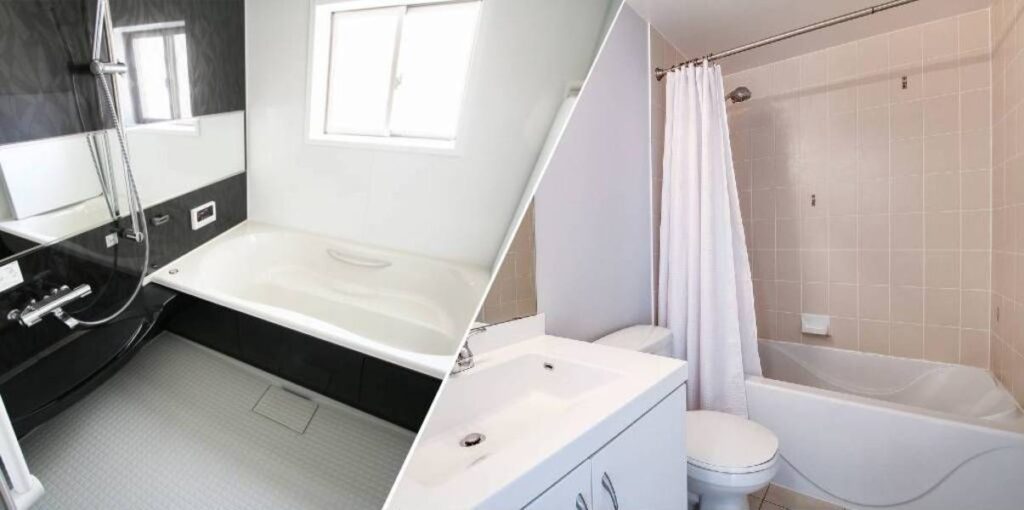When most people think of a bathroom, they picture a small room with a toilet, a sink or basin, and some kind of bathing facility (either a bathtub or a shower cubicle), all of which are crammed into the same space. It seems that this is the layout that is used in the majority of contemporary bathrooms all across the world.
On the other hand, the restrooms in Japan are not the same. But the issue is, why is that the case? Although it may seem apparent and practical to most people, the fact that the bathtub or shower, washbasin and toilet are all contained inside the same room in Japan is rationalised in a different way.
The Japanese Tradition of Soak and Shine

Only exceptionally affluent families were able to afford to have bathtubs installed in their homes during Japan’s traditional bathing practise, which included using public bathhouses known as sentos. In addition, before World War II, there were very few homes that had bathtubs, thus every single one was manufactured to order.
At the public baths, the method of using the common bathing rooms consisted of first washing one’s body outside of the tub, followed by a dip in warm water inside the tub itself. This practice of bathing persisted after World War II, when newly constructed houses were required to include bathtubs.
In its most fundamental sense, the function of a bathtub was and continues to be that of a place to unwind, as opposed to the cleaning function served by the typical contemporary bathing or showering space.
The benefits of participating in Soak and Shine go beyond only having a clean body; in addition to that, it is a good opportunity to think deeply and contemplate. The act of taking a bath in Japan is seen by a significant portion of the population as a means to clear one’s head and relieve oneself of the stresses of the day. They are able to accomplish a state of calmness and emotional equilibrium with the help of this practise.
The Typical Design of Japanese Restrooms

In the bathrooms in Japanese households, the toilet, wash basin and shower or bathtub are all located in their own individual rooms. A door will provide a barrier between the “wet” area and the “dry” region, serving as a separation between the toilet, which will be located in its own room, and the washbasin, which will be isolated from the bathing area by the door.
According to the norms of the traditional Japanese bathing culture, the shower in a Japanese bathing area is located outside of the bathtub, in contrast to the contemporary bathrooms seen all across the rest of the globe. After washing their body outside of the tub, one will enter the tub to relax and soak for a while.
Eighty percent of respondents to a recent poll on real estate claimed that they wanted a separate toilet and bathing room in their new apartment. The survey was conducted with individuals who were seeking for new apartments. This inclination may be explained by a number of factors, including the manner in which Japanese houses are constructed.
1. Houses With Only One Bathroom

In contrast to many other parts of the globe, even bigger residences with three to four bedrooms would often have just one washbasin, one toilet and one space designated for showering and bathing. By dividing the rooms up in this way, several individuals will be able to utilise them at the same time.
2. A Place Where One Can Unwind

In Japan, taking a bath is nearly like performing a ritual. Everyone in the family takes a turn getting cleaned up and then relaxing in the hot tub at the end of each day. Before going to bed, take some time to relax in the bathtub. Therefore, having a bathtub in the same area as a toilet is not conducive to a pleasant environment. In fact, the majority of Japanese people find the concept of bathing within visual range of a toilet to be quite unsettling.
3. Economising Water Use

Because the purpose of a bath is not to clean the body but rather to relax, the tub only has to be filled with water once, and then it may be used by everyone living in the home. In today’s high-tech bathtubs, the temperature can be automatically controlled, the water can be reheated as needed, and the water level can be maintained automatically so that the temperature and level of the water are maintained over the course of many hours.
4. Easier Maintenance

The first and most important guideline of house upkeep is to stay away from moisture and humidity. Because of the way the area is configured for a Japanese bathroom, one-third of it is damp and humid all the time. The amount of humidity that the sink and the toilet are subjected to may be substantially decreased by isolating the bathing area from the sink and the toilet. This helps to avoid the growth of mould and other types of damage that are connected with excessive levels of humidity.
This is not to mean that residences in Japan do not have access to contemporary bathrooms like those seen in other countries throughout the world. On the other hand, in order to make better use of the available space, they are often only seen in flats that are intended for a single occupant. When you are searching for an apartment, it might be helpful to define the kind of bathroom you want so that you can discover one that is the most comfortable for you.
The arrangement of a contemporary Japanese bathroom may take some getting used to at first, but there are many benefits to having the washbasin, toilet and bathtub or shower in separate areas. In fact, after using a modern Japanese bathroom, you may even find yourself wondering how you will ever return to a standard bathroom in the future!














